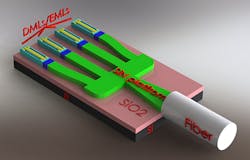MOICANA H2020 aims for heterogeneous integration of InP quantum-dot lasers on SiN platform
MOICANA (Thessaloniki, Greece) is a new ambitious European Union Horizon 2020 (H2020) R&D project launched in the beginning of this year that aims to develop fundamental innovations in the field of photonic integrated transmitters, making them cheaper and more power-efficient.
MOICANA is coordinated by Aristotle University of Thessaloniki in Greece and will be running throughout the period of January 2018 to December 2020. The project is funded under the H2020 ICT 2016-2017 – Photonics KET Call and the initiative of the Photonics Public Private Partnership.
The current approach to integrated optics for telecom optical transceivers, silicon photonics, has a major drawback; silicon photonic circuits need complex and expensive hybrid integration substrates, since they rely on externally coupled indium phosphide (InP) laser sources for the final assembly. Also the required redundant testing for the pre- and postprocessed coupled laser induces an additional cost increase.
To solve these problems, MOICANA aims to combine quantum-dot InP structures as the III-V light source material and SiN from the silicon photonics world as the passive platform. MOICANA is targeting cost-effective mass fabrication of optical transmitters via epitaxy of the quantum-dot InP components directly on Si by selective area growth.
MOICANA will highlight its technology through demonstrations of a new series of cooler-less, energy-efficient, high-performance single-channel and wavelength-division-multiplexing (WDM) transmitter modules for data-center interconnects for 5G mobile fronthaul and for coherent communication applications. The consortium is bringing together four industrial partners and four academic and research institutes in the photonic integrated circuit (PIC) and photonic systems industry. The participants include the Aristotle University of Thessaloniki (Greece), University of Kassel (Germany), Technion-Technical University of Israel (Israel), III-V lab (France), Mellanox Technologies (Israel), Ligentec (Switzerland), ADVA (Germany), and VLC Photonics (Spain).
For more info, see www.moicana.eu.
Source: MOICANA

John Wallace | Senior Technical Editor (1998-2022)
John Wallace was with Laser Focus World for nearly 25 years, retiring in late June 2022. He obtained a bachelor's degree in mechanical engineering and physics at Rutgers University and a master's in optical engineering at the University of Rochester. Before becoming an editor, John worked as an engineer at RCA, Exxon, Eastman Kodak, and GCA Corporation.
